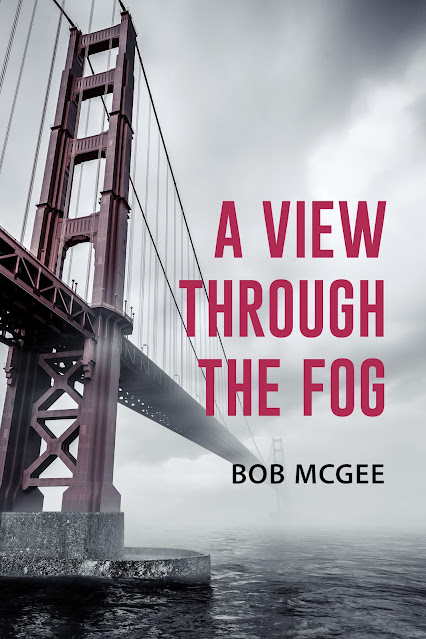Daily Excerpt: A View through the Fog (McGee) - Introduction
Today's book excerpt comes from Bob McGee's award-winning book, A View through the Fog:
INTRODUCTION
Heading southbound through
the Robin Williams Tunnel, formerly the Waldo Tunnel, on the way to the Golden
Gate Bridge humbles the soul nearly any morning as the strikingly beautiful San Francisco
skyline greets workers and visitors alike. A privileged
encounter with sun and sea! On the left, the radiating orb rising over the East
Bay Hills quietly lays its rays upon Alcatraz Island. On the right, the
picturesque Marin Headlands quietly yield to the endless expanse of the Pacific
Ocean. Scattered clouds in the the sky above cast their
silhouettes upon the towers of the Bridge.
On a foggy day, the Bridge develops its own
distinct environment: a white mist creeps along the Bridge, slowly wrapping its
arms around everyone and everything that moves, leading all into a shifting fog
bank. This thick white wall, accompanied by the eerie call of the Bridge
foghorns, gives the illusion that this mass of concrete and steel is perhaps a
living entity.
Clouds follow along her sidewalk from high in the
sky, creating an interplay of light and shadow upon the Bridge’s towers. The
gentle morning mist blankets everything in fog, teasing the senses with a faint
chill that almost isn’t there. Energy flows through the muted steel, and a hush
fills the emptiness, like a voice waiting to speak.
Hours later she gets
attention in other ways, channeling gusts of wind that tear through the body one
after the other, relentlessly, a reminder that great power lies behind her great
beauty—a clinging wind unwilling to let go.
She has given me views of San
Francisco Bay that are absolutely breathtaking. She has shared evenings with me
on her South Tower,
showing me dazzling sights of the city or the rising moon breaking through the
clouds at midnight over the ocean. These experiences always thrilled me with a delight
that I never tired of and will never forget. I used to think about how lucky I
was that Bridge Management did not know they were actually paying me to do a
job I would no doubt have done for free.
Still one of the most
recognized structures in the world, the Golden Gate Bridge is visited by more
than nine million tourists and admirers every year. With views very familiar,
yet unique to every facet of the Bridge’s environment, the Bridge ages, yet her
popularity never wanes.
I dreamed of being a painter
on the Golden Gate Bridge for many reasons. The Bridge is a tremendous
achievement in both design and construction. What an honor to be responsible
for keeping this architectural treasure safe in my hands! Constant maintenance
from a permanent paint crew is required to dress the Bridge with a coat of
International Orange, protecting her from the natural erosions of wind and fog,
along with the constant exposure of her steel to the salty sea air. It is the
most glorious job for any painter even though the job amounts to no more than
licking her wounds, and I was more than willing to risk life and limb to do my
part to keep her standing forever.
When I was a young boy in the
1970’s, my dad and grandpa took me fishing off the shores at the North End
under the Bridge. For the first time, I heard the deafening whistles from the sandblasters
that open-blasted the steel on the Bridge above. I witnessed sand shooting
everywhere, and I watched the spent sand flowing down the rocky cliffs into
huge piles on the path near where we were fishing. The distinct flinty smell of
sand dust filled the air as it wafted out over the bay. The noise, the sand,
the smell, the fog… what an impression it all made on me! I knew then, even at that
young age, that this was where I
wanted to work when I was older.
In those days, open blasting
was a common practice. Environmental restrictions on sandblasting did not
exist; containing the toxic
spent sand and paint chips was not a requirement. All that kept me from
jumping into those piles of sand that had streamed down the cliffs were my dad
and grandpa’s continued warnings that the sand was contaminated and unsafe.
They would certainly know as they were both retired painters who had spent
their careers painting steel in shipyards and oil refineries.
They had no desire for me to follow in their
footsteps. Steel painting is not an easy living, but when all other avenues in
my life had been exhausted, I became a painter. It was in my blood and seemed
to be my destined path. I toiled for years painting in oil refineries and on
other bridges around the San Francisco Bay until finally, in 2003, I landed my
dream job as a painter on the Golden Gate Bridge.
The popular image of what we
did for a living was largely a myth, one that we had no shame indulging. While
I worked at the Bridge, there were televised episodes about us on National Geographic, Modern Marvels,
and California’s Gold. Even Good Morning America filmed a
live segment that included some of our painters on the top of the North
Tower.
This type of coverage, along
with what the public could witness themselves, sustained the image that our job
differed greatly from most jobs. Painters were filmed casually straddling the main cable 700 feet above the
water or riding on a swing stage along the sides of the towers in perilous
weather conditions. Even our proximity to suicide jumpers added to the mystique
of our job. We were fearless, swashbuckling protectors of the steel.
I always enjoyed the privilege of interacting with so many tourists and visitors throughout the years. I am asked a variety of questions about my years at the Bridge, but often the same ones come up repetitively, making the answers also repetitious: “Yes, that is Alcatraz Prison; the color of the bridge is International Orange; an elevator in each tower goes to the top; no, we do not paint the bridge from one end to the other, then start again...” These kinds of conversations became part of our daily routine as Bridge painters.
Another not-so-trivial subject often inquired about by visitors to the Bridge and a question still asked today when people find out what I did for a living, is “What do you know about suicide jumpers?”
No
doubt, suicide jumpers come to mind when one thinks of the Golden Gate Bridge.
Questions concerning this subject may be asked out of harmless morbid
curiosity. Or, perhaps, misconception and urban myths fuel them, leading people
to believe that earthquakes and suicide jumps happen there every day, which, of
course, is not true.
Thousands
of tourists from all over the planet flock to the Golden Gate Bridge each day,
but it is no secret that the Bridge’s intrigue, mystique, and popularity also
attract another element: those looking to end their lives in a romanticized
manner by jumping from this famous landmark. I do not intend to analyze the
psychological reasons why a person leaps from the Bridge because I know little
about the subject. If the Bridge knows why people jump, she is unable to tell her
secrets, so I will do my best to share with you all I have witnessed regarding
jumpers. Along the way, I will try to answer some questions I’ve been asked
about suicide jumps at the Golden Gate Bridge.
The Bridge is a national monument,
so state and federal agencies funded most of our maintenance painting. This job
had it all: the best training, a powerful union, great pay, and super benefits.
The job appeared to be rock solid, but internally, the Paint Department began
crumbling from the decay of years past, caused by complacency, arrogance,
neglect, and greed.
I painted at the Golden Gate Bridge for 12 years, a small
window of time in the storied history of the painters on the Bridge, but it was
an important time because it marked the breakdown of our power structure, the
end of an era. Luxuries and perks that had ruled the Paint Department for many years
were being systematically extinguished by Bridge Management.
As employees, we were granted
a surprising amount of freedom to operate. A private culture facilitated by our
own grandiosity had long reigned within this world of seasoned veterans. The
egotism that sprang from our outmoded habits gave rise to an arrogance that
blinded us to the realities and truths of the entitled environment we had
created.
Survival depends upon adaptability; a reluctance to change some of the old ways and outdated traditions led to the Department’s decline. Self-awareness had slipped away. By the time we finally realized that our flamboyant customs were leading to our demise, it was too late.
I believe what happened behind
the scenes at the Bridge was infinitely more interesting than the exaggerated
myth that dominates mainstream thought. We were a diverse ensemble of
individuals and crews, all bound by a sense of loyalty both to each other and to
the job. The real Paint Department was a place where workers lost their
tempers, cracked jokes, and even fought, where each crew jealously guarded its turf,
and where slipups and misunderstandings
were common. I knew these workers professionally and personally, and
this was a place where I fit right in.
I will not fill this book
with facts and statistics that can easily be found in many other publications
about the Bridge. In recreating my experiences, I don’t want the narrative to
suffocate under a mass of technical detail and conjecture. However, for those
readers who need to quench a thirst for Bridge facts and figures, I have added
an appendix at the end of this book, which I hope you enjoy.
I have the advantage of being an amateur storyteller. My intention is to present a unique firsthand look at how we operated as high steel painters on the Golden Gate Bridge. I have made every effort to portray the events exactly as they occurred and to record, as accurately as possible, the actions of the painters who lived them. The more intimately we observe the essence of human habits, emotions, and responses, the better understanding we have of our subject. Writers do not always possess deeply personal insights about the world they are trying to describe. This was obviously not the case with me, and my aim here is to describe this world I know so well in a way that will make readers feel they are on the main cable with me.
Literary Titan gold award
Read more posts about Bob and his book, click HERE.
Sign up for the MSI Press LLC newsletter
Follow MSI Press on Twitter, Face Book, and Instagram.
in exchange for reviewing a current or forthcoming MSI Press LLC book?
Contact editor@msipress.com.
Want an author-signed copy of this book?
Purchase the book at 25% discount (use coupon code FF25)
and concurrently send a written request to orders@msipress.com.
Check out our rankings -- and more -- HERE.





Comments
Post a Comment